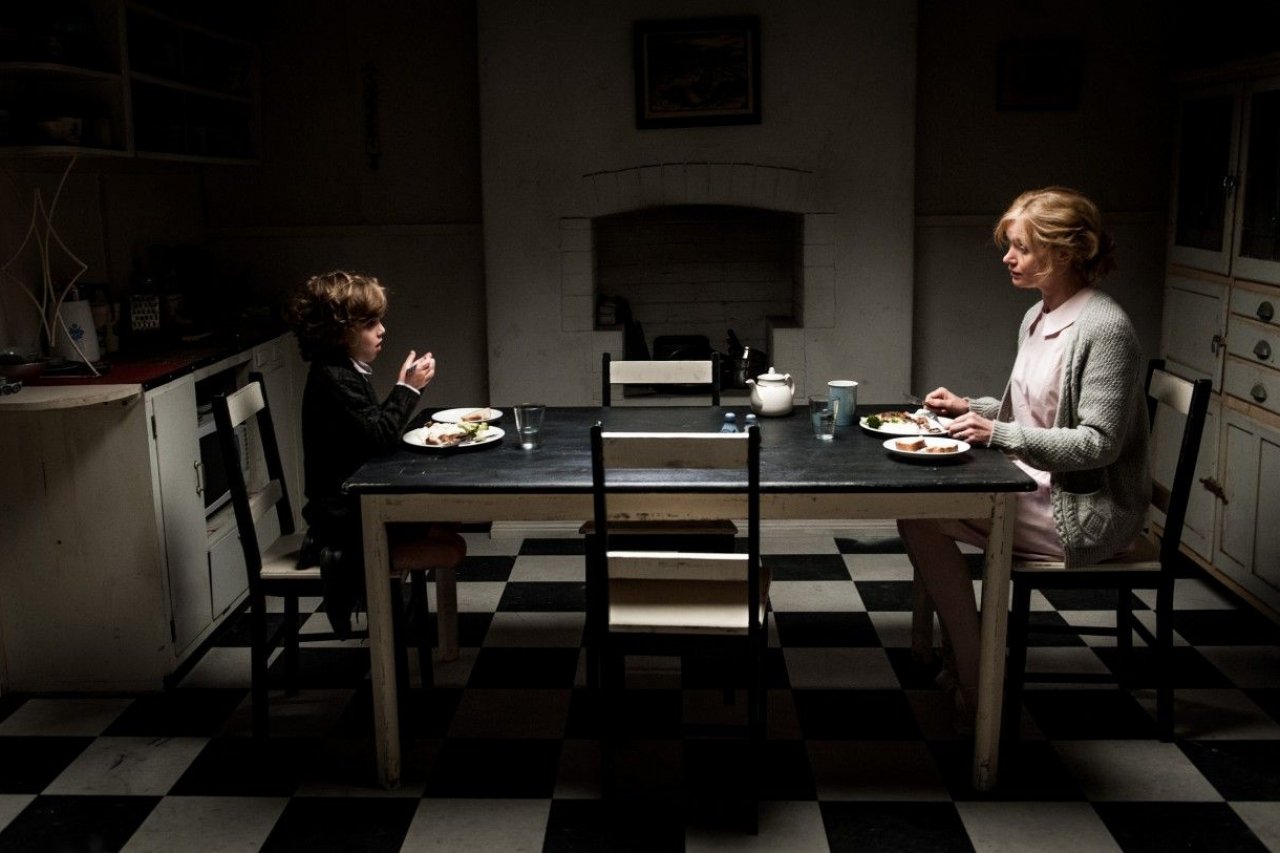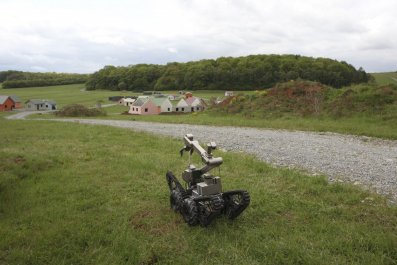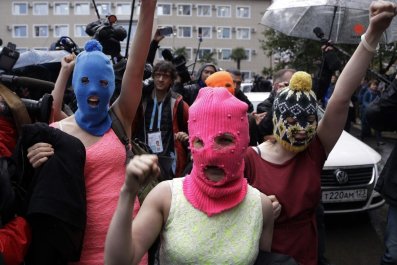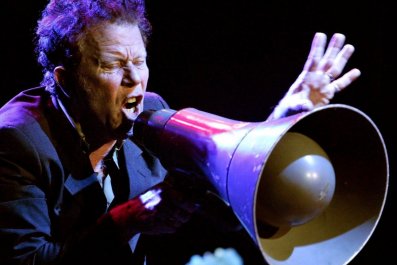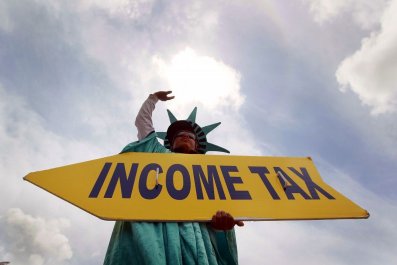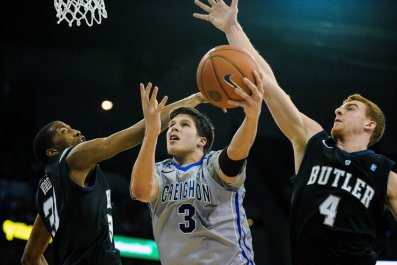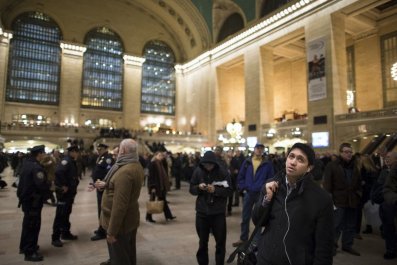You may think the Sundance Film Festival is all about Mongolian goat-herding documentaries, searches for Sugarmen, and six-hour Richard Linklater thumbsuckers starring Ethan Hawke. It's true that one of the most buzzed-about features at last month's fest was Linklater's Boyhood, but ghoul-hood was just as conspicuous. I ought to know. I sat through nearly all the midnight monster movies and lived to tell the tale. If you call this living.
Horror and independent film go together as neatly as Rosey Greer and Ray Milland in The Thing With Two Heads. The first narrative movie was an indie (by default: no studios) that played on the primal fears of its audience. At a 1903 screening of Edwin S. Porter's The Great Train Robbery, moviegoers reacted to the final close up of a mustachioed bandit firing a pistol directly at the camera lens by ducking, screaming and bolting from the theater. The first "art" film was Robert Weine's The Cabinet of Dr. Caligari (1920), an uber-stylized expressionist nightmare.
Though today horror films are often dismissed as genre schlock, many film festivals showcase the latest entries in their midnight programs. "Toronto [International Film Festival] has the biggest, baddest midnight audience," said Jim Mickle, director of last year's wildly popular cannibal flick We Are What We Are and this year's home-invasion thriller Cold in July. "But the audience in Park City is headier."
That's one word for the hordes that stay up late at Park City; they're also rowdier. The midnight shows have a long history of fistfights and drunken heckling. In 2012, two midnighters were treated by paramedics after witnessing graphic scenes at a screening of V/H/S. The always-reliable Daily Mail reported that the "lurid accounts of moviegoers passing out will no doubt lead some to suspect that this may have been an attempt to court publicity - but the film's production team insist what happened was real."
What the Fleet Street tabloid called the film's "vertigo-inducing moments" of wobbly camera-work recalled the festival's most famous midnight success story - The Blair Witch Project (1999), which, 15 years later, remains the most profitable indie of all time. Blair Witch was made for $60,000 and grossed $249 million worldwide, a sum two and a half times the total amassed by Park City's 2004 torture porn sensation Saw, which has spawned six sequels and a billion-dollar franchise. In other words, the real money at Sundance is not Before Sunset, Before Sunrise or Before Midnight, but during the witching hour.
Of course many of these midnight gross-outs never gross anything theatrically. More often than not, they fail to get distribution and are lucky to be released on iTunes. Nor are all midnight screenings frightening - the slate has included over-the-top comedies like Tim and Eric's Billion Dollar Movie, and surreal dramas, sci-fi, thrillers and docs geared toward late-night crowds, like last year's James Franco-produced skin-flick doc Kink.
Most premiere, appropriately, at the Egyptian Theatre, the oldest cinema in Park City. The movie house looks like a set from The Mummy - the Boris Karloff classic, not the de classe Brendan Frasier remake. The building's interior, designed by an Egyptologist in 1922 after the discovery of King Tut's tomb, is festooned with hieroglyphics, scarabs and lotus leaf motifs. (Midnight films that don't "do the Egyptian," screen at the Library Center Theatre, a converted high school gym). This year late-nighters loved the Egyptian because it was the only theater with a liquor license.
Of the eight films that played midnight, I saw four. I skipped The Guest (action) and The Signal (sci-fi) to focus on horror and monsters. I also passed on the 3-D concert doc Under the Electric Sky, which sounded too scary. (I live in mortal fear of glow sticks). And though I never caught Cooties, I did watch Kuti in Finding Fela, Alex Gibney's biography of the Nigerian musician who defined Afrobeat.
The Monster Show, David Skal's 1993 cultural history of horror, proposed that fright films reflect societies' current collective anxieties. And here's what Sundance's spooky selections tell us: Beware of ladies, especially the dead ones, the ones who want to be undead and the ones whose bodies have been overtaken by the dead. Whether it's your mother, your sister, your girlfriend or your personal assistant, she'll be the death of you - and herself. As Trey Parker's grade-school teacher Mr. Garrison confessed in South Park: Bigger, Longer & Uncut: "I don't trust anything that bleeds for five days and doesn't die."
The Babadook
The biggest hardship of going to midnight screenings at Sundance is having to miss the midnight parties. In the line of duty I turned down three invitations, including a chance to see Rick Ross perform at Tao nightclub - sorry Rick, looks like every day I'm hustling, too. The female protagonist of The Babadook embodies what Skal called the "werewolf-ish duality of Dr. Jekyll and Mr. Hyde."
The plot of this Australian psycho-shocker, written and directed by Jennifer Kent, involves a tormented single mother (Essie Davis, straw-haired and exquisitely pale). Her husband was killed in a car accident while rushing her to the delivery room. Mother and child survived, and now, with the seventh anniversary of the crash at hand, the squealing boy (Noah Wiseman) has been kicked out of school for his violent outbursts. He's far creepier than the monster he's sure lurks under his bed. His fears may be justified: A storybook titled Mr. Babadook shows up on his bedroom bookshelf and won't go away, no matter how many times Mom burns it.
The book is filled with Edward Gorey-like illustrations of the Babadook, a bogeyman with the hands of F.W. Murnau's Nosferatu and the diminutive stature of the Addams family's Cousin Itt. Every time the haunted book reappears, it has new pages that foretell new horrors. Is Mr. Babadook real or just a figment of Amelia's darkening imagination? Will he possess Amelia, make her murder her son and kill herself? As he skittered across ceilings like a top-hatted gecko, I rolled my eyes and gnawed at my fingernails. On the 20-minute walk back to my hotel, I found myself avoiding shadows and fire hydrants. As much as I shook my head at silly Mr. Babadook, I couldn't get him out of it.
Life After Beth
How did a comedy about cadavers starring Aubrey Plaza, Molly Shannon and John C. Reilly get lumped into the U.S. Dramatic Competition? And how did the zom-com premiere in broad daylight? Call it witchcraft.
On the red carpet before the screening, Reilly careened about in a too-big fedora and a too-long overcoat, as if he'd been taking fashion advice from Mr. Babadook. Asked to appraise the film, he said, semi-sincerely, that he "loved how whether someone was becoming a zombie or watching someone become a zombie, there's a real emotional truth going on."
I asked Shannon, about the current zombie problem - Is it a flash-in-the-pan, or something that should concern us, like the avian flu?
"It's terrible!" she said. "But I think Life After Beth will help soften the zombie image and all those negative things people think about zombies."
Shannon expressed the hope that the film would be a "step forward" for actresses playing zombies as well as zombie actresses: "I'm glad it's a woman's game now."
Plaza plays Beth, a brain-hungry, smooth jazz-loving rotter who dies of a snakebite, gets buried, crawls out of her grave, rekindles her romance with her boyfriend (Dane DeHaan) and inadvertently kindles part of a boardwalk. Asked if the guys she's dated in real life ever seemed like zombies, she said, "Yes."
What made you feel that way?
"They tried to eat me."
Alas, the predigested inanity of Life After Beth's script was even harder to swallow. Basically, the movie was dead-on-arrival.
What We Do in the Shadows
This Real World-style mock doc centers on a quartet of New Zealand vampires who fret about hitting the main artery, feast on O positive, and try to resolve roommate conflicts. Jemaine Clement (co-star of HBO's Flight of the Conchords) and Taika Waititi (director of the Kiwi hit Eagle vs. Shark) headline as, respectively, the torture-loving Vladislav - age 862 - and 379-year-old Viago, a 17th century dandy who, though he has never seen himself in a mirror, broods obsessively about his hair, clothes and skin tone. Vladislav's explanation of why vampires are obsessed with virgins: "If you're eating a sandwich, would you want someone to already have f****d it?"
The best fiends hire a human personal assistant (Jackie Van Beek) to lure fresh victims to their crib and rinse off their bloody kitchenware, but she never succeeds in finding them bona fide virgins. Like the crypts at Castle Dracula, What We Do in the Shadows is crammed with groaners (scornful of profanity, a wolf-man howls, "We're werewolves, not swearwolves!") After the first 300 or so, I began to feel like one of the bloodsuckers' victims: drained.
Dead Snow: Dead vs. Red
The 2009 Norwegian zombie send-up Dead Snow was directed and co-written by Tommy Wirkola, whom New York Times critic Manohla Dargis reckoned, "doesn't just hit every horror beat; he pounds it to an indistinguishable pulp." Will Ferrell and Adam McKay (Anchorman, Talladega Nights) were such fans of the film that they hired Wirkola for Hansel & Gretel: Witch Hunters and its forthcoming sequel. "Tommy eats reindeer meat, loves heavy metal, is able to be funny in a second language and is a truly decent guy," McKay told me. "He's a truly original writer-director, which is one of the rarest things there is."
In the first Dead Snow, a group of Norwegian medical students climb into the mountains during winter break and - as often happens to college kids who head to cabins in the middle of nowhere - awaken a frozen battalion of Nazi zombies. Lively patter and deadly splatter ensue. In Dead vs. Red, the unarmed (and armless) survivor (Vegar Hoel) is on the run from the same undead Waffen-SS soldiers, but this time around the corpse corps is hell-bent on completing its original mission to raze a small village. How to stop them? Why, sew an arm of the Nazi zombie colonel onto the med student and have him rouse Red Army zombie-sicles - Russian POW's killed by the Germans, of course!
Killers
The terror finale at the Egyptian was filmed in Tokyo and Jakarta by the Indonesian director duo the Mo Brothers - Timo Tjahjanto and Kimo Stamboel. A Japanese executive and an Indonesian journalist become online pen pals and, eventually, competing serial killers. Their brutality is perpetrated with hammers, guns, wrenches, knives and a baseball bat that's thrust into a woman's mouth and emerges through the back of her head.
Which seemed to be part of the monstrous-female pattern. The she-monster of Killers is the late, but not-quite-departed sister of one of the slayers. She's a dead ringer - literally - for Norman Bates's mother.
Shannon would be truly horrified to learn that Japanese and Indonesian shock cinema have long been women's games.
What's the difference between the two?
"Japanese horror has Japanese girls with long-haired wigs," Tjahjanto says, semi-wryly. "Indonesian horror has Indonesian girls with long-haired wigs."



